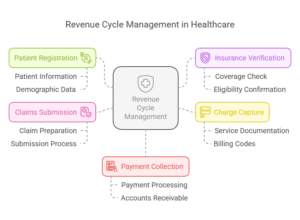On-Demand Outsourcing BPO Services for Healthcare Providers With 24/7 Coverage!
Save up to 70% on staffing costs!
Browse Specialty Staffing ServicesRevenue Cycle Management in Healthcare: Key Steps for Success

Revenue Cycle Management (RCM) is the process by which healthcare organizations manage their financial transactions, from patient intake to the final payment for services rendered. A well-optimized RCM system ensures that healthcare providers receive timely and accurate payments, reduce claim denials, and enhance overall financial performance. Implementing effective RCM processes helps organizations maintain healthy cash flow and focus on providing high-quality patient care.
In this article, we will explore the key steps involved in healthcare revenue cycle management and how each step contributes to overall financial success.

1. Patient Scheduling and Registration
The revenue cycle begins with patient scheduling and registration. Accurate patient information is crucial for ensuring proper billing and insurance verification. Key actions include:
- Collecting patient demographics: Ensure accurate information such as name, address, insurance provider, and contact details.
- Insurance verification: Confirm patient insurance coverage before services are provided to reduce the risk of claim denials.
- Pre-registration: Collect and verify required details in advance, helping to streamline the process on the day of the visit.
Accurate registration sets the foundation for the rest of the revenue cycle, ensuring that claims can be processed efficiently.
2. Charge Capture
Charge capture refers to recording the services provided to a patient, ensuring that all procedures, tests, and treatments are accurately documented for billing purposes. Key actions include:
- Documenting services: Ensure that all services provided are accurately recorded using proper codes (CPT, ICD-10).
- Monitoring for missed charges: Implement processes to ensure that no services are left unbilled, leading to revenue leakage.
- Using Electronic Health Records (EHR): Utilize EHR systems to ensure accurate documentation of services and facilitate seamless charge capture.
This step is critical in preventing underbilling or missing charges, which can negatively impact revenue.
3. Coding
Accurate coding is essential for ensuring that the services provided are correctly represented and reimbursed by insurance companies. Key actions include:
- Medical coding: Use proper coding systems (ICD-10, CPT, HCPCS) to ensure that diagnoses and treatments are billed appropriately.
- Verification of codes: Cross-check codes with the medical records to avoid errors that could lead to claim denials.
- Utilizing coding software: Implement coding software or systems that streamline the coding process and reduce human error.
Proper coding is one of the most important factors in ensuring that healthcare providers are reimbursed accurately and promptly.
4. Insurance Verification and Authorization
Before services are provided, verifying the patient’s insurance coverage and obtaining necessary authorizations is vital. Key actions include:
- Verifying eligibility: Check if the patient’s insurance is active and covers the services being provided.
- Obtaining prior authorization: Some services require prior authorization from the insurance provider. Ensure that this is obtained before proceeding.
- Documenting coverage details: Keep accurate records of the patient’s insurance coverage and any specific requirements or restrictions.
This step helps reduce claim denials and ensures that services are covered under the patient’s insurance plan.
5. Claims Submission
Once the patient’s details are confirmed, charges are coded, and services are documented, claims are submitted to insurance payers. Key actions include:
- Electronic claim submission: Submit claims electronically through clearinghouses to streamline the process and reduce human error.
- Ensuring accurate coding and documentation: Verify that the correct codes, modifiers, and documentation are included to avoid denials.
- Timely submission: Ensure that claims are submitted in a timely manner, meeting the payer’s deadlines.
Timely and accurate claims submission is essential for ensuring quick reimbursements and avoiding delayed payments.
6. Claims Management and Follow-Up
Once claims are submitted, it’s essential to track their progress and follow up on any issues that arise. Key actions include:
- Monitoring claim status: Use claim management software to track the status of submitted claims and identify any issues.
- Resolving claim denials: If a claim is denied, investigate the reason and resolve the issue by correcting errors or providing additional documentation.
- Appealing denials: When necessary, appeal denied claims by submitting additional information or correcting errors to get the claim reimbursed.
Efficient claims management ensures that rejected or denied claims are addressed promptly, minimizing lost revenue.
7. Patient Billing and Collections
After insurance payments are processed, healthcare providers must bill patients for any remaining balance, including copays, deductibles, and coinsurance. Key actions include:
- Generating patient bills: Send clear, itemized bills to patients that include details of services provided, insurance payments, and outstanding balances.
- Offering payment plans: For patients who cannot pay the full amount upfront, offer flexible payment options, such as payment plans.
- Patient communication: Use patient-friendly billing statements and reminders to encourage timely payments.
Effective billing and collections are essential for maintaining cash flow and ensuring that all outstanding balances are collected.
8. Payment Posting
Payment posting is the process of applying received payments to the appropriate patient accounts. Key actions include:
- Accurate posting: Ensure that payments from insurance providers and patients are posted correctly to the corresponding accounts.
- Reconciliation: Regularly reconcile payments with claims to ensure that there are no discrepancies or missed payments.
- Tracking adjustments: Apply any necessary adjustments for overpayments, write-offs, or discounts based on insurance contracts or patient agreements.
Payment posting ensures that the revenue cycle remains accurate and up-to-date, supporting financial transparency.
9. Reporting and Analytics
Once the revenue cycle processes are complete, it’s important to analyze the data to identify trends, areas for improvement, and revenue leakage. Key actions include:
- Generating financial reports: Use reporting tools to generate key performance indicators (KPIs) such as collections, aging reports, and denial rates.
- Tracking performance: Monitor revenue cycle metrics to assess performance and identify inefficiencies or areas where revenue is being lost.
- Making improvements: Use the insights gained from reports to make data-driven decisions and improve the revenue cycle.
Regular reporting and analysis ensure continuous improvement in the revenue cycle and contribute to long-term financial success.
10. Continuous Improvement
The revenue cycle is dynamic, and improvements should be made regularly to adapt to changes in the healthcare industry. Key actions include:
- Identifying inefficiencies: Regularly review the revenue cycle processes to identify inefficiencies or areas that need improvement.
- Training staff: Continuously train staff on billing codes, payer requirements, and compliance to ensure accuracy and reduce errors.
- Implementing new technology: Stay updated with the latest RCM software, AI tools, and automation solutions that can improve efficiency and reduce administrative costs.
Ongoing improvement in the revenue cycle management process helps healthcare organizations maintain profitability and operational efficiency.
Conclusion
Revenue cycle management is a complex, multi-step process that involves several key actions to ensure that healthcare organizations receive timely and accurate payments for services provided. By focusing on each step—patient registration, charge capture, coding, insurance verification, claims submission, and more—healthcare providers can optimize their revenue cycle, reduce administrative costs, and improve overall financial performance. Effective RCM not only ensures financial health but also allows healthcare providers to focus on delivering quality patient care.
What People Are Asking
1. What are the main steps in revenue cycle management?
The main steps include patient registration, charge capture, coding, insurance verification, claims submission, follow-up, patient billing, payment posting, reporting, and continuous improvement.
2. How can RCM improve cash flow for healthcare providers?
RCM improves cash flow by ensuring accurate coding, timely claims submission, efficient denial management, and quick payment collection from both insurers and patients.
3. How does insurance verification affect revenue cycle outcomes?
Insurance verification ensures that services are covered, reducing the risk of denials and ensuring that healthcare providers are reimbursed for the services provided.
4. What role does coding play in the revenue cycle?
Accurate coding ensures that services are billed correctly, directly impacting reimbursement rates and minimizing the risk of claim denials.
5. How can healthcare providers improve their revenue cycle management?
Healthcare providers can improve RCM by implementing automation, improving staff training, reducing claim denials, and regularly analyzing revenue cycle data to identify areas for improvement.
Disclaimer
For informational purposes only; not applicable to specific situations.
For tailored support and professional services,
please contact Staffingly, Inc. at (800) 489-5877
Email: support@staffingly.com.
About This Blog: This Blog is brought to you by Staffingly, Inc., a trusted name in healthcare outsourcing. The team of skilled healthcare specialists and content creators is dedicated to improving the quality and efficiency of healthcare services. The team passionate about sharing knowledge through insightful articles, blogs, and other educational resources.
 Book a Demo to Build Your Team Today!
Book a Demo to Build Your Team Today!
 Read Case Studies
Read Case Studies 


 Virtual Medical Assistants
Virtual Medical Assistants



